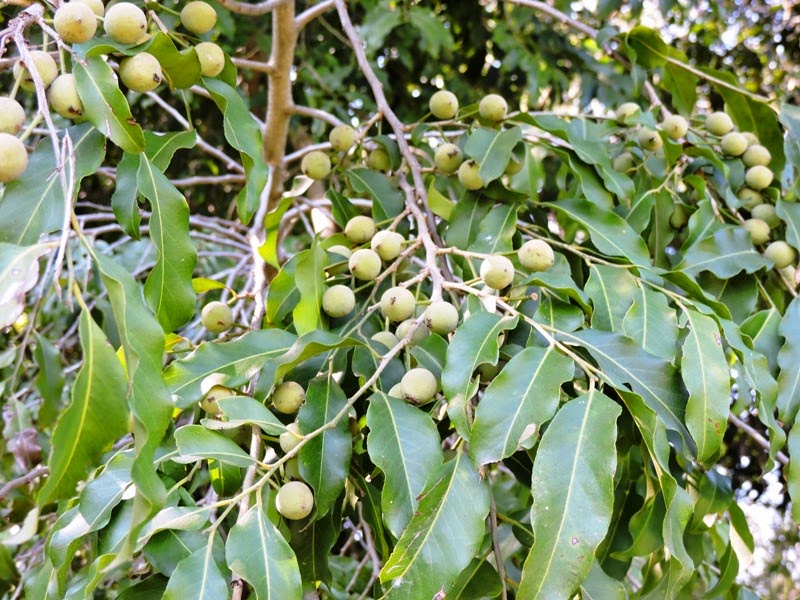Vernacular
names:
Hindi & Sanskrit names: पुत्रजीव, पुत्रजीवः, जीवपुत्रक, पुत्रजीवी, पुत्रंजीवः, जियापुत, पुतिजिया
Bengali: Putarjeeva, Jiaputa
Kannada: Putrajiva, Amani
Marathi: Putojan, Jewanputar
Telgu: Putrajivika, Kudrajivi
Kannada: Putrajiva, Amani
Marathi: Putojan, Jewanputar
Telgu: Putrajivika, Kudrajivi
Botanical
name: Putranjiva roxburghii
Botanical
name, Putranjiva roxburghii given by Wallich in 1826, is inspired from the Hindi and Sanskrit names (Putranjiva= Putarjiya + roxburghii= Dr. William Roxburgh, the father
of Indian Botany).
Distribution: India, Pakistan, Bangladesh, Nepal, Sri Lanka, Indochina, Malaysia, Indonesia, New Guinea.
Flowering Branch
BOTANICAL DESCRIPTION
The children's life tree is a medium sized tree reaching a height of nearly 20m. The branches are generally pendent and the branchlets are brown, thin, and pubescent. Leaves are simple, alternate, stipulate, petiolate, dark green, shining and coriaceous. Leaf lamina is 3.5-12 cm x 1.5-4.5 cm and elliptic-oblong. Leaf margin is serrate or serrulate. Flowers are unisexual, small and pale yellow. Male flowers are sessile, arranged in axillary spikes and 2-2.5 mm in size. Female flowers are solitary or in groups of 2 or 3, axillary and puberulous. Fruit is a drupe measuring 1.3-2 cm x 1.5 cm, ovoid-ellipsoid and white tomentose.
Fruits
USES
Sacred Uses:
The
hard seeds of this plant are strung into necklaces that are put around the necks
of young children. It is considered to ward off evil spirits and ill health.
Hindu Saints use to wear necklaces and rosaries made from its seeds. The children's life tree is worshiped by Hindu women wishing to give birth to a child. Watt, G. (1885-1893) has described many of its folk uses in his book
"Dictionary of the Economic Products of India" published by the Government of India.
Putrajeevak Seeds Mala
(Photo courtesy: Astrodevam.com)
Medicinal Uses:
The seeds of children's life tree are considered to have rejuvenative and restorative properties for the
female reproductive system and their overall health. Decoction of the leaves and
seeds is given in colds. It is also considered to have analgesic, antipyretic
and anti-inflammatory activities. The seeds are considered beneficial for liver problems, irregular menstruation, rheumatic problems and allergic skin rashes.
Other Uses:
Wood
is used for house building, agricultural implements and tool handles. Leaves
are lopped for fodder. Seeds yield a fatty oil used for burning.
More than 100 years old children's life tree growing in Vadodara
(Photograph courtesy: Dr. Jitendra Gavali Ji)







23 comments:
Written after parliamentary discussion on Putrajiva by our politicians in May 2015.
Very nice and interesting Sir..
Very good dear friend
Very good dear friend
Good work. Please keep it up. My good wishes.
Very scientific comprehensive information.
सर बहुत ही बढ़िया प्रयास है
Nice n interesting information
Well done Sir
Nature is supreme. Very interesting
Nature is supreme. Very interesting
Nature is supreme. Very interesting
Beautiful tree notes,Dr.Anil Thakur ji.👍
Can u eat the green apple like fruit it is white and pear like inside
Thanks for sharing your blog for us.
Great blogging, very informative and engaging posts.
Nice
Once Baba Ram Dev was in Stockade only because of the same Plant.
Maharaja Gulab Singh of Jammu Kashmir had his Coronation/ RajTilak under the same tree (Jiopota in JK) 17th June 1822. Now the Place is called Jeopota Ghat ; nearby River Chenab, Akhnoor, Jammu.
Very good information, thanks for this compilation
Consolidated in brief the information and introduction of the plant beneficial foe raders at a glance.
A tree close to my heart.
There is a big tree at the birth place of 17 the century Ayurveda physician Itty Achuthan(of Hortus Malabaricus)at Cherthala believed to be planted by him.8 years back when I asked nobody knew what it is.Found out it as P.roxburghii after a big effort.
Sirs,
We have this tree..we use it as medicine.
Thank you for the information, Sir
Post a Comment